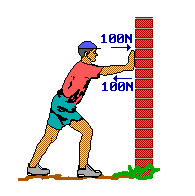Newton's Third Law of Motion: Difference between revisions
Lkrishnan7 (talk | contribs) |
Lkrishnan7 (talk | contribs) |
||
| Line 59: | Line 59: | ||
F = M * a → 100 = (30+m) * 2.5 | F = M * a → 100 = (30+m) * 2.5 | ||
m = 10 kg | m = 10 kg | ||
==Connectedness== | ==Connectedness== | ||
Revision as of 21:44, 8 April 2017
By Karan Shah

Main Idea
Newton’s Third Law of Motion describes a push or pull that acts on an object as a result of its interaction with another object. According to this law for every action there is an equal and opposite re-action. This means that for every force there is a reaction force that is equal in size, but opposite in direction. Meaning that when an object 1 pushes another object 2 then object 1 gets pushed back with equal force but in the opposite direction.


The third law of motion is also referred to as the action-reaction law because both objects are part of a single interaction and neither force can exist without the other. An important concept to remember about Newton's Third Law of Motion is that the two forces are of the same type. For example, when you throw a ball in the sky the Earth exerts a gravitational force on the ball and the ball also exerts a

gravitational force that is equal in magnitude and opposite in direction on the earth. Another example, that can sum up the concept of Newton's Third Law is when you walk. When you push down upon the ground and ground pushes with the same force upward. Similarly, the tires of a car push against the road while the road pushes back on the tires.
Examples
Here are some problems regarding Newton's Third Law.
Simple
Question

Car B is stopped at a red light. The brakes in Car A have failed and Car A is coming towards Car B at 60 kmh. Car B then runs into the back of Car A, What can be said about the force on Car A on Car B and the force on Car B on Car A?
Answer
B exerts the same amount of force on A as A exerts on B. Just the direction of both the forces will be in the opposite direction.
Middle
Question
Blocks with masses of 1 kg, 2 kg, and 3 kg are lined up in a row on a frictionless table. All three are pushed forward by a 8 N force applied to the 1 kg block. (a) How much force does the 2 kg block exert on the 3 kg block? (b) How much force does the 2 kg block exert on the 1 kg block?
Answer
(a) Find the Acceleration of the Whole Object: Total Mass: 6kg 8 = (6) a a = 8 / 6 = 1.33 m/s^2 Total Acceleration: 1.33 m/s^2 (Acceleration will be the same for all three blocks) F(2 on 3) = m(3) * a 3 * 1.33 = 3.999 N
(b) Total Acceleration: 1.33 m/s^2 Mass to push: 5 kg (Because we are also pushing the 3 kg block) F(1 on 2) = 5 * 1.33 F(1 on 2) = 5.33 N
Difficult
Question
A massive steel cable drags a 30 kg block across a horizontal, frictionless surface. A 100 N force applied to the cable causes the block to reach a speed of 5.0 m/s in a distance of 5.0 m. What is the mass of the cable?
Answer
a = V² / (2x) = 2.5 m/s² F = M * a → 100 = (30+m) * 2.5 m = 10 kg
Connectedness
- How is this topic connected to something that you are interested in?
Newton's Third Law is connected to the concept of a spacecraft flying in space. When a spacecraft fires a thruster rocket, the exhaust gas pushes against the thruster and the thruster pushes against the exhaust gas. The gas and rocket move in opposite directions. This is an example of Newton's Third Law because both forces are equal in magnitude and opposite in direction. This topic is related to space travel a topic that I am interested in and passionate about learning more.
History
Sir Isaac Newton was a renowned scientist and mathematician who helped create a foundation for modern studies. He was born in England in 1643 and worked his way to earn a bachelor’s and master’s degree from Trinity College Cambridge. He was highly interested in math, physics, and astronomy and wrote many of his ideas in a journal. One of those ideas was about the three laws of motion.

In 1687 Isaac Newton made his work on his book, Philosophiae Naturalis Principia Mathematic or Principia known to the public. He discussed the principles of time, force, and motion that helped create modern physical science and helped account for much of the phenomena viewed in the world. Some of the principles he discusses include acceleration, initial movement, fluid dynamics, and motion. Newton’s Laws first appeared in the Principia and discussed the relationship that exists between forces acting on a body and the motion of the body. For the third law, he stated that for every action/force in nature, there will be an equal and opposite reaction.
See also
Further reading
Books, Articles or other print media on this topic
A Closer Look at Newton’s Third Law
What happens when Newton's third law is broken?
How Are Newton's Three Laws of Motion Used in Baseball?
Light can break Newton’s third law – by cheating
External links
Internet resources on this topic
References
This section contains the the references you used while writing this page
Knight, R., & Jones, B. (n.d.). College physics: A strategic approach (Third edition, Global ed.).
http://www.physicsclassroom.com/class/newtlaws/Lesson-4/Newton-s-Third-Law
https://www.grc.nasa.gov/www/k-12/airplane/newton3.html